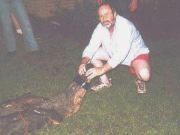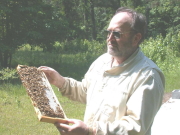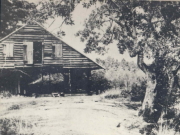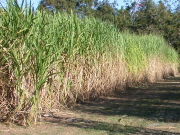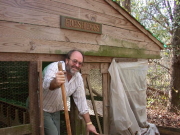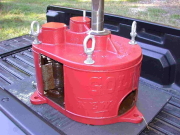Snapshots 46-60
 Born in Scotland in 1808 and
trained as a cabinet maker, Robert Findlay made his way to America via Liverpool in
1828, just a year before the first steam locomotive came to America and also just a
year before the first steam boat reached Macon, Georgia. Railroads thus competed with
canals and meant that heavy items, such as stationary engines, could be shipped
anyplace, as long as a railroad was built. Within ten years, Findlay became an expert
machinist and assembled locomotives, but the details of his exact relationships with
concerns in Pennsylvania are not clear. In any case, in 1838, he escorted one of these
locomotives, the Ocmulgee, to Macon, Georgia, which had been designated as one
of the three commercial cities in Georgia. Findlay soon left the railroad business and
went into a partnership, the Macon Brass & Iron Works and Machine Shop. Within a
year, he was the sole proprietor and employed 20 men, eight being slaves. By the time
of his death in 1859, the list of items Findlay Iron Works offered was comprehensive,
and, of course, included sugar mills and boilers. One of these landed up with Kyle
Fuller ( Fitzgerald, Georgia), who has a huge collection of antique farm equipment.
Here, Kyle stands by this example (Slide 46) made by Findlay’s . This unusual kettle, like the one to its left,
has a full round bottom, dissimilar to the deeper “salt” kettles and to the
usual shallow “ New York” pattern kettles. Interestingly, the
“n” cast in “ Macon” was set backwards! Findlay Iron Works
outlasted Crockett and Reynolds, two Macon foundries that went under in the 1890s. It,
however, was not up to competing with larger concerns such as Schofield's or Taylor and
Findlay's ceased to exist in 1912 under a court-enforced sale. The last of the foundry
buildings was condemned in 1951 and his mansion was demolished for a parking lot in
1974. (Special thanks to Dr. Christopher Stokes of the Washington Memorial Library
(Macon, Georgia). The historical data are summarized from the eminently readable book
by Robert S. Davis Jr. (1998 Cotton, fire, and dreams. The Robert Findlay Iron
Works and heavy industry in Macon, Georgia, 1839-1912. Mercer University
Press.))
Born in Scotland in 1808 and
trained as a cabinet maker, Robert Findlay made his way to America via Liverpool in
1828, just a year before the first steam locomotive came to America and also just a
year before the first steam boat reached Macon, Georgia. Railroads thus competed with
canals and meant that heavy items, such as stationary engines, could be shipped
anyplace, as long as a railroad was built. Within ten years, Findlay became an expert
machinist and assembled locomotives, but the details of his exact relationships with
concerns in Pennsylvania are not clear. In any case, in 1838, he escorted one of these
locomotives, the Ocmulgee, to Macon, Georgia, which had been designated as one
of the three commercial cities in Georgia. Findlay soon left the railroad business and
went into a partnership, the Macon Brass & Iron Works and Machine Shop. Within a
year, he was the sole proprietor and employed 20 men, eight being slaves. By the time
of his death in 1859, the list of items Findlay Iron Works offered was comprehensive,
and, of course, included sugar mills and boilers. One of these landed up with Kyle
Fuller ( Fitzgerald, Georgia), who has a huge collection of antique farm equipment.
Here, Kyle stands by this example (Slide 46) made by Findlay’s . This unusual kettle, like the one to its left,
has a full round bottom, dissimilar to the deeper “salt” kettles and to the
usual shallow “ New York” pattern kettles. Interestingly, the
“n” cast in “ Macon” was set backwards! Findlay Iron Works
outlasted Crockett and Reynolds, two Macon foundries that went under in the 1890s. It,
however, was not up to competing with larger concerns such as Schofield's or Taylor and
Findlay's ceased to exist in 1912 under a court-enforced sale. The last of the foundry
buildings was condemned in 1951 and his mansion was demolished for a parking lot in
1974. (Special thanks to Dr. Christopher Stokes of the Washington Memorial Library
(Macon, Georgia). The historical data are summarized from the eminently readable book
by Robert S. Davis Jr. (1998 Cotton, fire, and dreams. The Robert Findlay Iron
Works and heavy industry in Macon, Georgia, 1839-1912. Mercer University
Press.))
 Picture postcards often portray old timey syrup making. This particular
one (Slide 47) is endearing to me, showing an operation near Tallahassee
with the extraction and cooking facilities, along with the people who lived that life.
(Thanks to Anthony Brinson for sharing this postcard.)
Picture postcards often portray old timey syrup making. This particular
one (Slide 47) is endearing to me, showing an operation near Tallahassee
with the extraction and cooking facilities, along with the people who lived that life.
(Thanks to Anthony Brinson for sharing this postcard.)
 My
father’s brother, Buren (1917-1976), made syrup for a few years. After he returned from the
war, he sharecropped with Uncle
Cornelius and Aunt Lena for one year and then worked with his in-laws as discussed
above (Slide 45). Farming was hard and in the mid 1950s, he and his family moved
near Lakeland ( Florida) where some of Aunt Bessie’s people had already migrated.
The thought of Uncle Boo, as I called him, never fails to bring a smile to my face. He
was a daredevil but did not grow out of it as most boys, including I, did. As a boy, I
have been told, he would climb into trees overhanging the river. When an unwary
alligator swam past, Uncle Boo would startle the poor creature by diving near it. I
might not believe such a story except that I knew Uncle Boo: one night, he, Daddy, and
I put a small boat into a sizeable lake in central Florida. The "No Trespassing" signs
apparently meant more to the crowd of drunks on a deck across the lake than they did to
Uncle Boo because they started shooting at us. Daddy immediately had me lie down in the
bottom of the boat and he crouched over me. Uncle Boo noted the situation and remarked,
perhaps to calm Daddy, that he didn’t think they could hit us from where they
were. So, Uncle Boo’s night fishing went on. Pardon this digression, but the
essence of the character of people who worked cane mills needs to be told, too. Anyhow,
finding the mill Uncle Boo used became a priority for me and I was prepared to buy it, if necessary, to preserve
it. After the property was split up, the mill moved down to Quitman to the farm of John
Robinson, Aunt Bessie’s brother. Mr. John had passed on and the ownership of the
mill was not clear, and in any case, I failed to find it. A second trip, however, was
more fruitful (Slide 48). This is one of the later versions of the Goldens' No. 2
(New Model) as indicated by its guide-knife design, and is consistent with a new mill being set up
after Rev. William Robinson removed from what is now known as the John Harper place.
The improved guide knife is a welcome feature (discussed elsewhere), although most
extant No. 2s in my area predate its invention.
My
father’s brother, Buren (1917-1976), made syrup for a few years. After he returned from the
war, he sharecropped with Uncle
Cornelius and Aunt Lena for one year and then worked with his in-laws as discussed
above (Slide 45). Farming was hard and in the mid 1950s, he and his family moved
near Lakeland ( Florida) where some of Aunt Bessie’s people had already migrated.
The thought of Uncle Boo, as I called him, never fails to bring a smile to my face. He
was a daredevil but did not grow out of it as most boys, including I, did. As a boy, I
have been told, he would climb into trees overhanging the river. When an unwary
alligator swam past, Uncle Boo would startle the poor creature by diving near it. I
might not believe such a story except that I knew Uncle Boo: one night, he, Daddy, and
I put a small boat into a sizeable lake in central Florida. The "No Trespassing" signs
apparently meant more to the crowd of drunks on a deck across the lake than they did to
Uncle Boo because they started shooting at us. Daddy immediately had me lie down in the
bottom of the boat and he crouched over me. Uncle Boo noted the situation and remarked,
perhaps to calm Daddy, that he didn’t think they could hit us from where they
were. So, Uncle Boo’s night fishing went on. Pardon this digression, but the
essence of the character of people who worked cane mills needs to be told, too. Anyhow,
finding the mill Uncle Boo used became a priority for me and I was prepared to buy it, if necessary, to preserve
it. After the property was split up, the mill moved down to Quitman to the farm of John
Robinson, Aunt Bessie’s brother. Mr. John had passed on and the ownership of the
mill was not clear, and in any case, I failed to find it. A second trip, however, was
more fruitful (Slide 48). This is one of the later versions of the Goldens' No. 2
(New Model) as indicated by its guide-knife design, and is consistent with a new mill being set up
after Rev. William Robinson removed from what is now known as the John Harper place.
The improved guide knife is a welcome feature (discussed elsewhere), although most
extant No. 2s in my area predate its invention.
 Letterheads of two major players in the sugar-cane syrup industry are
shown in Slide 49. Roddenbery, located in Cairo ( Georgia), was a packer and
produced a variety of cane-based sweeteners and other products as discussed later. Note
that this is a modern letterhead, as indicated by the presence of a postal code. The
cane patch, though, was inspired by a pre-Civil War photograph. The Golden letterhead,
used until the 1950s, depicts the 1890s building that replaced the one built in 1882,
which burned. The building still stands, although the smoke stacks have been removed
and additions made. The officers are not the original company officers. (Thanks to
Anthony Brinson for sharing the Roddenbery letterhead and to Dennis Parker for sharing
the Golden letterhead and providing information.)
Letterheads of two major players in the sugar-cane syrup industry are
shown in Slide 49. Roddenbery, located in Cairo ( Georgia), was a packer and
produced a variety of cane-based sweeteners and other products as discussed later. Note
that this is a modern letterhead, as indicated by the presence of a postal code. The
cane patch, though, was inspired by a pre-Civil War photograph. The Golden letterhead,
used until the 1950s, depicts the 1890s building that replaced the one built in 1882,
which burned. The building still stands, although the smoke stacks have been removed
and additions made. The officers are not the original company officers. (Thanks to
Anthony Brinson for sharing the Roddenbery letterhead and to Dennis Parker for sharing
the Golden letterhead and providing information.)
 Awesome, so often overused, is the only proper word to describe the
Goldens' No. 44x (New Model) (Slide 50). This mill is owned by Mr. Oliver Broom ( Ocilla,
Georgia) who purchased it from Mr. Joe Fletcher ( Irvinville, Georgia) and nothing else
is known. This mill “was designed to meet the demand of some of our customers for
a ‘Heavier Mill’ especially adapted for Hard Stubble and Tropical
Cane.” This series of mills (viz. 22x, 33x, 44x) was not offered in Golden
Catalog No. 34 (~1916) (or No. 37, 1919) but was offered in Golden Catalog No.53 (1933) (and No. 52, 1928). The 44x was apparently a
replacement for the No. 4xx. Like the 4xx, the 44x has a juice capacity of 150 gallons
per hour. The roller size of the 44x is about the same as that of the 4xx and of the
Columbus
No. 15 (i.e., ~12” x 16” (diameter)). The weights of these mills are
1385 lbs (No. 4xx), 1530 lbs. (No. 44x), and 2000 lbs. (Columbus No. 15). These very
large vertical mills are rare. As of this writing (July 2004), this is the only one of
the 22x-33x-44x series that I know of. I am aware of only two 4xx mills (Tommy Clayton’s, Bobby
McDaniel's and mine ) and only one Columbus No. 15 mill (again, Tommy
Clayton’s).
Awesome, so often overused, is the only proper word to describe the
Goldens' No. 44x (New Model) (Slide 50). This mill is owned by Mr. Oliver Broom ( Ocilla,
Georgia) who purchased it from Mr. Joe Fletcher ( Irvinville, Georgia) and nothing else
is known. This mill “was designed to meet the demand of some of our customers for
a ‘Heavier Mill’ especially adapted for Hard Stubble and Tropical
Cane.” This series of mills (viz. 22x, 33x, 44x) was not offered in Golden
Catalog No. 34 (~1916) (or No. 37, 1919) but was offered in Golden Catalog No.53 (1933) (and No. 52, 1928). The 44x was apparently a
replacement for the No. 4xx. Like the 4xx, the 44x has a juice capacity of 150 gallons
per hour. The roller size of the 44x is about the same as that of the 4xx and of the
Columbus
No. 15 (i.e., ~12” x 16” (diameter)). The weights of these mills are
1385 lbs (No. 4xx), 1530 lbs. (No. 44x), and 2000 lbs. (Columbus No. 15). These very
large vertical mills are rare. As of this writing (July 2004), this is the only one of
the 22x-33x-44x series that I know of. I am aware of only two 4xx mills (Tommy Clayton’s, Bobby
McDaniel's and mine ) and only one Columbus No. 15 mill (again, Tommy
Clayton’s).
 Wayne Davis
(Peniel (near Clopton), Alabama) (Slide 51) holds a cane hoe. Wayne confided that he buys every old piece of
American-made equipment that he runs across. (After seeing his workshop, I would have
come to this conclusion anyhow.) In my youth's experience, hand-harvesting of cane was
always done with a large cane knife, but hoes such as the one that Wayne is holding
were shown in early sugar-cane syrup bulletins and are used by some growers I know
today.
Wayne Davis
(Peniel (near Clopton), Alabama) (Slide 51) holds a cane hoe. Wayne confided that he buys every old piece of
American-made equipment that he runs across. (After seeing his workshop, I would have
come to this conclusion anyhow.) In my youth's experience, hand-harvesting of cane was
always done with a large cane knife, but hoes such as the one that Wayne is holding
were shown in early sugar-cane syrup bulletins and are used by some growers I know
today.
 All except one of the labels in
this composite (Slide 52) are from Cairo, Georgia, which is the seat of Grady
County, and which, for decades, was the center for shipment of sugar-cane syrup to
other parts of the U.S. Two of the labels are from the Roddenbery Company, which is
particularly notable in the cane-syrup industry. The founder and patriarch of this
large family business was Dr. Seaborn Roddenbery, a third-generation Georgian. In 1862,
he bought a farm (Cross Roads, bottom label) on what is now Hiway 84 between
Thomasville and Bainbridge ( Georgia). Within the decade, he had acquired 1000 acres
and eased off his practice of medicine because, he complained, 90% of his customers
didn’t pay. Readers of these pages perhaps know of Roddenbery’s sugar-cane
syrup industry, which in the end was producing on Cross Roads alone 120 barrels of
syrup a 24-hour day on one long evaporator. The company also bought and sold various
syrups (including sorghum and maple) and a large variety of blends under many labels.
(The company started blending with corn syrup only in 1919 in order to satisfy the
requirements of customers who were not willing to pay the high prices for the pure
syrup.) Many readers might be interested to know that the Roddenbery enterprises were
diversified into a variety of products: early in the 20th century, they grew, bought,
and shipped hundreds of train cars of watermelons; the Roddenberys made cigars, ran a
hardware business and mercantile business, and they made Cairo famous all over South
Georgia during my childhood for the prodigious amount and variety of pickles they
produced. That era has passed, too; the Roddenbery business is no more, being sold to
Dean Foods, which closed the Cairo operation shortly afterwards. (Thanks to Anthony
Brinson for allowing me to scan the labels and to Alan Kaye and Janet Boudet of
Roddenbery Memorial Library ( Cairo, Georgia) for courteous essential assistance. Most
of the facts were taken from Gwendolyn Brock Waldorf 1995 W. B. Roddenbery Company,
Grady County, Georgia, unpublished).
All except one of the labels in
this composite (Slide 52) are from Cairo, Georgia, which is the seat of Grady
County, and which, for decades, was the center for shipment of sugar-cane syrup to
other parts of the U.S. Two of the labels are from the Roddenbery Company, which is
particularly notable in the cane-syrup industry. The founder and patriarch of this
large family business was Dr. Seaborn Roddenbery, a third-generation Georgian. In 1862,
he bought a farm (Cross Roads, bottom label) on what is now Hiway 84 between
Thomasville and Bainbridge ( Georgia). Within the decade, he had acquired 1000 acres
and eased off his practice of medicine because, he complained, 90% of his customers
didn’t pay. Readers of these pages perhaps know of Roddenbery’s sugar-cane
syrup industry, which in the end was producing on Cross Roads alone 120 barrels of
syrup a 24-hour day on one long evaporator. The company also bought and sold various
syrups (including sorghum and maple) and a large variety of blends under many labels.
(The company started blending with corn syrup only in 1919 in order to satisfy the
requirements of customers who were not willing to pay the high prices for the pure
syrup.) Many readers might be interested to know that the Roddenbery enterprises were
diversified into a variety of products: early in the 20th century, they grew, bought,
and shipped hundreds of train cars of watermelons; the Roddenberys made cigars, ran a
hardware business and mercantile business, and they made Cairo famous all over South
Georgia during my childhood for the prodigious amount and variety of pickles they
produced. That era has passed, too; the Roddenbery business is no more, being sold to
Dean Foods, which closed the Cairo operation shortly afterwards. (Thanks to Anthony
Brinson for allowing me to scan the labels and to Alan Kaye and Janet Boudet of
Roddenbery Memorial Library ( Cairo, Georgia) for courteous essential assistance. Most
of the facts were taken from Gwendolyn Brock Waldorf 1995 W. B. Roddenbery Company,
Grady County, Georgia, unpublished).
 Jerry and
Anthony Brinson ( Whigham, Georgia) own this magnificently restored set of fly-wheel
engines (Slide 53). The engines represent the entire set of M-series International
Engines, which range from 1.5 to 10 horsepower and which were produced from 1919 to
~1930. The largest engine, which was introduced in 1920, was used in Mr. John H.
Collins’ syrup operation, which produced over 10,000 gallons of syrup in 1921.
Born in 1869 to an established family, Mr. Collins grew up on the homeplace on Hadley
Ferry Road, which intersects with Meridian Road about 6 miles north of me. He was a
progressive farmer and conscientious citizen, helping to form Grady County and
electrify it later. He grew a number of crops, but also had a large milling operation
in addition to his syrup operation. (The data on Mr. Collins were from Yvonne Brunton
1979 Grady County, Georgia. Some of its history, folk architecture and
families. Quality Printers, Inc. Jackson MS. Thanks to Janet Boudet and Alan Kaye
of the Roddenbery Memorial Library for assistance. Thanks also to Jerry and Anthony
Brinson for information about the engines.)
Jerry and
Anthony Brinson ( Whigham, Georgia) own this magnificently restored set of fly-wheel
engines (Slide 53). The engines represent the entire set of M-series International
Engines, which range from 1.5 to 10 horsepower and which were produced from 1919 to
~1930. The largest engine, which was introduced in 1920, was used in Mr. John H.
Collins’ syrup operation, which produced over 10,000 gallons of syrup in 1921.
Born in 1869 to an established family, Mr. Collins grew up on the homeplace on Hadley
Ferry Road, which intersects with Meridian Road about 6 miles north of me. He was a
progressive farmer and conscientious citizen, helping to form Grady County and
electrify it later. He grew a number of crops, but also had a large milling operation
in addition to his syrup operation. (The data on Mr. Collins were from Yvonne Brunton
1979 Grady County, Georgia. Some of its history, folk architecture and
families. Quality Printers, Inc. Jackson MS. Thanks to Janet Boudet and Alan Kaye
of the Roddenbery Memorial Library for assistance. Thanks also to Jerry and Anthony
Brinson for information about the engines.)
-s.JPG)
Postscript: I regret to note that Brother Mark Webb passed December 16, 2012.
 My
small hometown, Nashville (GA), is about half way between Tifton and Valdosta. I always
thought of Valdosta as “the city,” and Tifton as a larger version of
Nashville and as the place where I suffered at the hands of a merciless dentist.
Certainly, Valdosta has a more auspicious name, coming by way of Gov. Troupe’s
estate’s name (itself named after the small French region in NW Italy). Although
Troupe ultimately gave the name to Valdosta, the honorific Troupeville, a steamboat
stop on the Withlacoochee River (Creek: Small River), lost its status as the county
seat when the county seat removed to the new rail lines four miles away in 1860. (For a
pleasant read, go here; for a pleasant ride,
canoe the Withlacoochee.) This entire introduction is simply to make the point that
Valdosta was a mere thirty years old when this 1890s photograph of Briggs Hardware
(Slide 55) was made on Patterson Street. In the 1910s, Briggs moved to
another location, and now it is no more. Can you imagine jumping onto the wagon, riding
a day or so, and picking up a new kettle? First noticed by Beth Clayton, Briggs also
had a couple of cane mills on the porch. (Thanks to Beth and Tommy Clayton (who
own a Golden Mill No.1 with a Briggs Hardware tag) and indirectly to the Lowndes County
Historical Society.)
My
small hometown, Nashville (GA), is about half way between Tifton and Valdosta. I always
thought of Valdosta as “the city,” and Tifton as a larger version of
Nashville and as the place where I suffered at the hands of a merciless dentist.
Certainly, Valdosta has a more auspicious name, coming by way of Gov. Troupe’s
estate’s name (itself named after the small French region in NW Italy). Although
Troupe ultimately gave the name to Valdosta, the honorific Troupeville, a steamboat
stop on the Withlacoochee River (Creek: Small River), lost its status as the county
seat when the county seat removed to the new rail lines four miles away in 1860. (For a
pleasant read, go here; for a pleasant ride,
canoe the Withlacoochee.) This entire introduction is simply to make the point that
Valdosta was a mere thirty years old when this 1890s photograph of Briggs Hardware
(Slide 55) was made on Patterson Street. In the 1910s, Briggs moved to
another location, and now it is no more. Can you imagine jumping onto the wagon, riding
a day or so, and picking up a new kettle? First noticed by Beth Clayton, Briggs also
had a couple of cane mills on the porch. (Thanks to Beth and Tommy Clayton (who
own a Golden Mill No.1 with a Briggs Hardware tag) and indirectly to the Lowndes County
Historical Society.)
In Irwin County (GA), I bumped into a lever cap (Slide 56) cast with “W Green SA” on it. It appears to have originally gone on a cane mill.
 If you cannot overcome the temptation to covet,
better not to go to the Brinsons’. Elsewhere, the
Chattanooga No. 92 that was used by the sugar-cane experiment station in Cairo was
described in the context of its use at the station. According to information given to
Anthony Brinson, the station was established in 1917 at the intersection of Hadley
Ferry Road and Pine Park Road. Neighboring farmers complained about the high wages paid
to laborers because they could not compete. So, the station was moved soon to its
permanent home at 361 Hiway 112 (the present location of Conner Nursery), where it
remained until the station was closed by the Nixon administration. The inventory
indicated that the mill was part of the move. Since the mill does not have IHC cast
into it anyplace, Anthony surmised that it was made before International Harvester
acquired Chattanooga Plow Company in 1919. The Brinsons use it at the Swine Time Festival for grinding juice, powering it
with either their 10-hp flywheel engine or their antique McCormick tractor. As shown in
Slide 57, the mill is mounted on a military surplus generator buggy and is
equipped with a pump to move the juice into the 95-gallon holding vat. The
multicomponent drive system for the pump operates at 2500 RPM whereas the cane-mill
pulley only turns 200 RPM.
If you cannot overcome the temptation to covet,
better not to go to the Brinsons’. Elsewhere, the
Chattanooga No. 92 that was used by the sugar-cane experiment station in Cairo was
described in the context of its use at the station. According to information given to
Anthony Brinson, the station was established in 1917 at the intersection of Hadley
Ferry Road and Pine Park Road. Neighboring farmers complained about the high wages paid
to laborers because they could not compete. So, the station was moved soon to its
permanent home at 361 Hiway 112 (the present location of Conner Nursery), where it
remained until the station was closed by the Nixon administration. The inventory
indicated that the mill was part of the move. Since the mill does not have IHC cast
into it anyplace, Anthony surmised that it was made before International Harvester
acquired Chattanooga Plow Company in 1919. The Brinsons use it at the Swine Time Festival for grinding juice, powering it
with either their 10-hp flywheel engine or their antique McCormick tractor. As shown in
Slide 57, the mill is mounted on a military surplus generator buggy and is
equipped with a pump to move the juice into the 95-gallon holding vat. The
multicomponent drive system for the pump operates at 2500 RPM whereas the cane-mill
pulley only turns 200 RPM.
Like most of us, the Abernethys (Maiden, NC) started in the syrup
business with a
vertical animal-powered mill. They were lucky to find one that had local history. Their
first mill had been owned by a blacksmith who lived only a half mile away and whose
wife had a side-line sorghum operation. In the 1970s, Carroll Abernethy’s uncle
obtained that mill and they made syrup using it until 2003. Slide
58 shows Carroll standing by his restored Goldens’ No. 36, which he obtained
from Colbert (GA), where it had been used for many years. Originally, it had come from
the North Georgia mountains.
with a
vertical animal-powered mill. They were lucky to find one that had local history. Their
first mill had been owned by a blacksmith who lived only a half mile away and whose
wife had a side-line sorghum operation. In the 1970s, Carroll Abernethy’s uncle
obtained that mill and they made syrup using it until 2003. Slide
58 shows Carroll standing by his restored Goldens’ No. 36, which he obtained
from Colbert (GA), where it had been used for many years. Originally, it had come from
the North Georgia mountains.
Anthony Brinson made another great find (Slide 59). The front of the postcard shows a 1916 postal mark and the back elaborates on the qualities of the “Boss” cane stripper. Note that this design differs from those made by the Brinley-Hardy Company (Snapshot 43.)
Al Fuqua, an antique collector and dealer from Springfield (Tennessee), brought this Murphy mill (Slide 60) to the site of the NSSPPA annual meeting in Nashville (Tennessee) in 2005. W.L. Murphy & Co., Manufacturers ( Nashville, Tennessee) is shown on the top plate and Southern Mill, No. 2 is cast onto one of the staves. (Thanks to Ken Christison for assistance with this narrative.)
